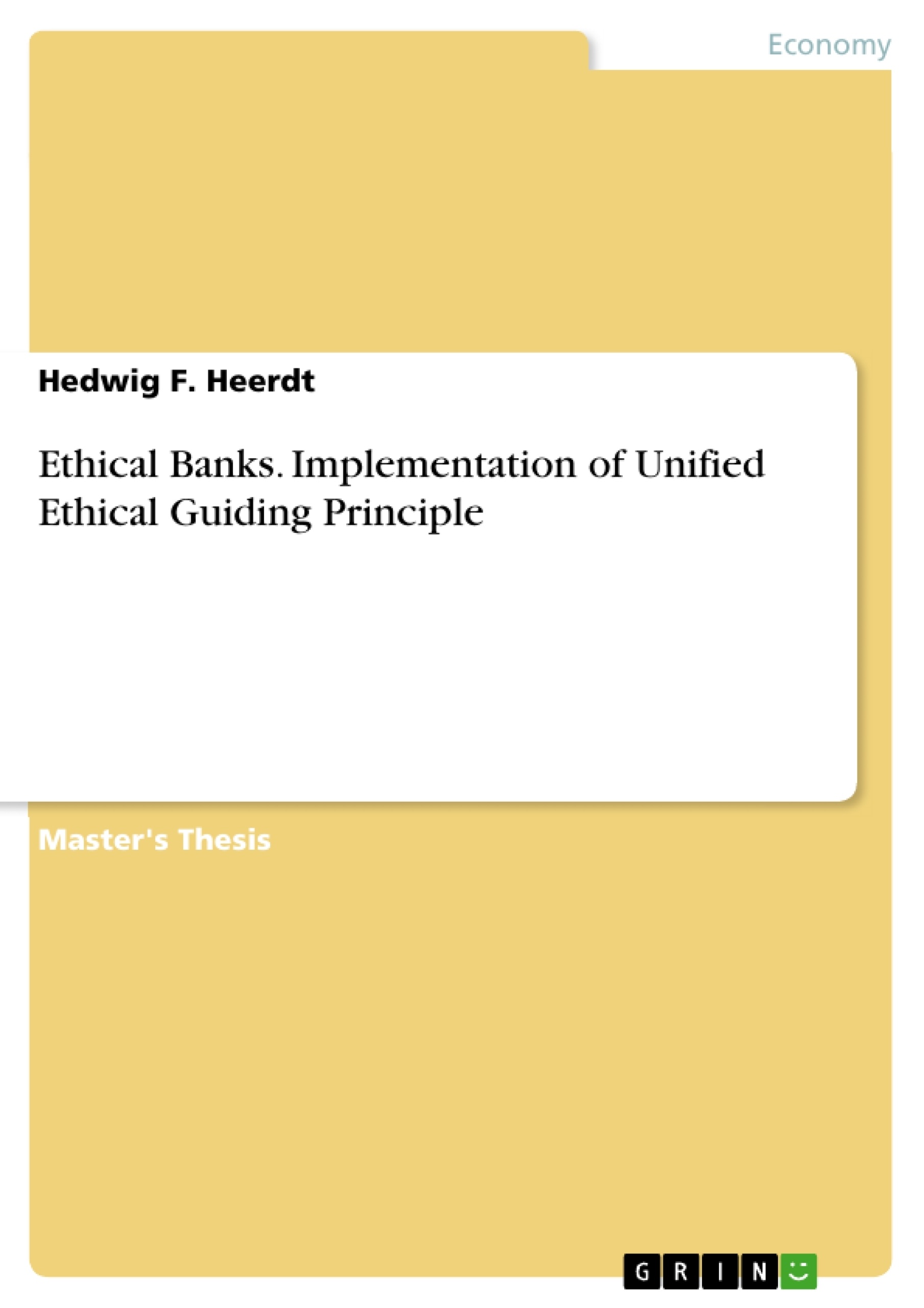Because Ethical Banks have developed from niche players to serious competition for traditional banks, supposedly Ethical Banks and even traditional banks use the term Ethical Bank in order to sell bank services under the cloak of sustainable and ethically correct business conduct.
Therefore, the focus of this research is to make truly Ethical Banks distinguishable from traditional banks by investigating, analysing and determining principles, Ethical Banks have to fulfil or refrain from in order to call themselves truly ethical. Based on the results of the academic research, a web- based survey identifies bank customer’s attitude towards sustainability and ethics in general, their banking, as well as their ethical attitude towards nine areas of business, banks may be confronted with. The survey result build the basis for a list of positive and negative Ethical Guiding Principles (EGPs), which should serve as a general standard for Ethical Banks that want to settle down within the European Economic Area and Switzerland.
The main conclusion drawn from this study is a comprehensive list of positive and negative EGPs, applicable either directly to Ethical Banks or as a basis for further research. But because of the ever-changing environmental, social and legal environment, EGPs need to be continuously reviewed and validated. If directly implemented, a control mechanism within or outside the bank must monitor and ensure compliance with these principles.
Table of Contents
- Abstract
- Acknowledgements
- Table of contents
- Table of figures
- List of tables
- List of abbreviations
- Introduction
- Background
- Research focus
- Research aim and objectives
- Outline structure
- Literature Review
- Ethical Banks
- Definition
- The role of Ethical Banks
- Stages of sustainability
- Measuring social and environmental development
- Environmental Reporting
- Ethical Performance Measurement
- Ethical Guiding Principles
- Ethical decision making
- Definition
- Theories
- Teleology
- Deontology
- Virtue ethics
- Ethical learning and growth
- Stakeholder Theory
- Emerging issues and the need for empirical research
- Ethical Banks
- Theoretical Framework
- Data and methodology
- Research design
- Post-positivism
- Inductive research approach
- Survey
- Research process
- Survey method and distribution
- Survey design
- Research process
- Data collection and analysis
- Practical research problems
- Research design
- Findings and analysis of results
- Respondents' characteristics and attitude towards different bank types
- Evaluation of ethical criteria
- Leisure and entertainment
- Animals and plants
- Weapons
- Energy
- Medical and pharmaceuticals
- Commodities
- Transportation
- Law, International Agreements, Corporate Governance
- Finance and Support
- Final list of criteria
- Conclusion
- Summary of findings
- Limitations
- Opportunities for further research
- References
- Appendix A
- Appendix B
Objectives and Key Themes
This research aims to distinguish truly Ethical Banks from traditional banks by identifying principles that Ethical Banks must fulfill or refrain from. This analysis is conducted through investigating and analyzing the principles that define truly ethical banks. The research employs a web-based survey to understand bank customer attitudes toward sustainability, ethics in general, and their banking practices. The survey explores ethical attitudes regarding nine business areas that banks may encounter. The findings of the survey are used to create a list of positive and negative Ethical Guiding Principles (EGPs), which are intended to serve as a general standard for Ethical Banks within the European Economic Area and Switzerland.- Defining and distinguishing truly Ethical Banks from traditional banks
- Identifying and analyzing principles that define truly ethical banks
- Understanding bank customer attitudes towards sustainability and ethics
- Developing a comprehensive list of positive and negative Ethical Guiding Principles (EGPs)
- Proposing EGPs as a general standard for Ethical Banks within the European Economic Area and Switzerland
Chapter Summaries
- The introduction provides background information on the evolution of Ethical Banks, defines the research focus, outlines the research aim and objectives, and presents the structure of the thesis.
- The literature review examines various aspects related to Ethical Banks, including their definition, role, stages of sustainability, and measurement methods for social and environmental development. It further delves into ethical decision-making theories, stakeholder theory, and emerging issues that necessitate empirical research.
- The chapter on the theoretical framework outlines the research design, which employs a post-positivist and inductive research approach. The survey method, distribution, and design are detailed, along with the data collection and analysis processes.
- The chapter on findings and analysis of results presents the characteristics of the respondents and their attitudes toward different bank types. The chapter then evaluates ethical criteria across nine business areas: leisure and entertainment, animals and plants, weapons, energy, medical and pharmaceuticals, commodities, transportation, law, international agreements, corporate governance, and finance and support. The chapter concludes by presenting a final list of criteria based on the analysis.
Keywords
This research focuses on ethical banking, sustainability, ethical guiding principles, customer attitudes, empirical research, and the distinction between truly ethical banks and traditional banks. It explores the implementation of ethical principles in banking practices and aims to contribute to a standardized framework for ethical banking within the European Economic Area and Switzerland.- Citar trabajo
- Hedwig F. Heerdt (Autor), 2013, Ethical Banks. Implementation of Unified Ethical Guiding Principle, Múnich, GRIN Verlag, https://www.grin.com/document/214262



